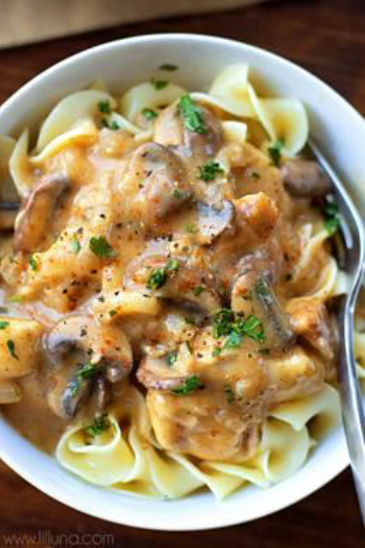In a large skillet over medium-high heat, add 1 tablespoon of olive oil.
Meanwhile, place the cut chicken into a bowl and season with garlic powder, onion powder, paprika, cayenne pepper, and ½ teaspoon each of salt and pepper; toss to combine.
Place the chicken in the hot pan (taking care not to overcrowd-you may need to do two batches) and brown, about 2-5 minutes on each side. The chicken does not need to be cooked throughout. Remove from the pan and transfer to a plate (continue with remaining chicken if needed).
Add the remaining tablespoon of oil to the skillet. Add the mushroom and cook until brown, about 4 minutes. Add the shallot, onion and garlic and stir occasionally until they are soft and translucent. Pour in the wine and cook for 1 minute, then add the butter and flour. Whisk continuously taking care not to burn. Slowly add the chicken stock, whisking to create a smooth sauce. Add the Worcestershire, thyme, and the remaining salt and pepper. Bring to a simmer and allow the sauce to thicken.
Toss in the chicken, turn the heat down to medium-low and continue to cook for 5-8 minutes. Add the egg noodles and sour cream and stir until combined. Cook for 2 minutes, add salt and pepper to taste, then remove from heat and garnish with parsley, if desired.
Vitamin D, otherwise known as the sunshine vitamin, is found in virtually every tissue in the body and enables many biological functions, but its main role is in the regulation and absorption of calcium and phosphorous in the body. Rickets in children and osteomalacia, osteopenia, and osteoporosis in adults are the most well-established consequences of vitamin D deficiency. Vitamin D has been of much interest with researchers over the past 15 years, with hundreds of studies on vitamin D’s potential role in risk reduction of diseases such as cancer, heart disease, stroke, diabetes, autoimmune diseases, infectious diseases, and neurocognitive disorders. Much of this research is ongoing and may provide more definitive answers in the future. A simple blood test can determine if you are deficient in vitamin D. According to the Institute of Medicine, a vitamin D level of less than 20ng/ml would be considered a deficiency. The Institute of Medicine also recommends 600 IU per day for people between 1 and 70 years old (including pregnant and lactating women) and 800 IU per day for anyone over 71 years old. However, most Americans fall short in the Vitamin D department. Those at particular risk of vitamin D deficiency include overweight or obese individuals, those who have undergone gastric bypass surgery, older adults, people with limited sun exposure and people with conditions causing fat malabsorption (vitamin D is fat-soluble). You can get vitamin D from three sources: food, supplements, and the sun. If you try to get vitamin D from food alone, it won’t be easy. There is a relatively limited number of foods rich in vitamin D. Foods which naturally contain higher amounts of vitamin D include salmon, sardines, trout, mackerel, tuna, and fish liver oils. Fortified foods such as milks, juices, and breakfast cereals are also dietary sources of vitamin D. Vitamin D₃ supplements may be necessary for some individuals to fill nutrient gaps. Multivitamins often usually include vitamin D as well. For most people, taking a once-daily multivitamin supplement that includes vitamin D along with a healthy diet is sensible. It’s important to remember though that no one nutrient is better than the sum total of a healthy eating pattern.
Ingredients
Directions
In a large skillet over medium-high heat, add 1 tablespoon of olive oil.
Meanwhile, place the cut chicken into a bowl and season with garlic powder, onion powder, paprika, cayenne pepper, and ½ teaspoon each of salt and pepper; toss to combine.
Place the chicken in the hot pan (taking care not to overcrowd-you may need to do two batches) and brown, about 2-5 minutes on each side. The chicken does not need to be cooked throughout. Remove from the pan and transfer to a plate (continue with remaining chicken if needed).
Add the remaining tablespoon of oil to the skillet. Add the mushroom and cook until brown, about 4 minutes. Add the shallot, onion and garlic and stir occasionally until they are soft and translucent. Pour in the wine and cook for 1 minute, then add the butter and flour. Whisk continuously taking care not to burn. Slowly add the chicken stock, whisking to create a smooth sauce. Add the Worcestershire, thyme, and the remaining salt and pepper. Bring to a simmer and allow the sauce to thicken.
Toss in the chicken, turn the heat down to medium-low and continue to cook for 5-8 minutes. Add the egg noodles and sour cream and stir until combined. Cook for 2 minutes, add salt and pepper to taste, then remove from heat and garnish with parsley, if desired.


